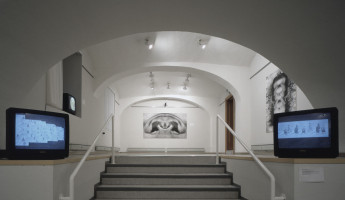time to time
3 channel computer animation 1992
intro
In the exhibition „Differenzen - Affinitdten - Br|che: Zeitschnitt ‘92“ Herwig Turk exhibited an installation of three monitors entitled „Time to Time“, each of them showing a computer animation. Basically, these animations were based on every-day events (such as someone crossing a street). The processes were split up into individual picture segments, processed and deferred at re-assembly: a continuous loop was created, numerous moments in time were superimposed in each picture segment so that at any given time in the „action“ all other moments shone through - animated pictures of a permanent present.
text
Reinhard Braun (1996)
Herwig Turk : Time to Time
In the exhibition „Differenzen - Affinitäten - Brüche: Zeitschnitt ‘92“ Herwig Turk exhibited an installation of three monitors entitled „Time to Time“, each of them showing a computer animation. Basically, these animations were based on every-day events (such as someone crossing a street). The processes were split up into individual picture segments, processed and deferred at re-assembly: a continuous loop was created, numerous moments in time were superimposed in each picture segment so that at any given time in the „action“ all other moments shone through - animated pictures of a permanent present.
Here, too, it is less the formal solution that is interesting, but the specific „relief“ of representation that is created by manipulation. Within each animated loop the temporary and „ontological“, i.e. referential connections can be changed and varied, the contents of the pictures are flexible and independent of each other. As various points of time in an action are pro- jected onto each other, a new image of time is created; after all, with electronic and digital images are first and foremost forms of time. The picture field is the site of permanent recur-sion ultimately referring to a logic immanent to the media. The point is neither in the motif or the aesthetic form, nor in a representation, but in the logic, the grammar of the synthetic picture itself, a flux of pictures which is no longer created as a narrative, nor as the fragment of such a narrative, for that matter, but as the visualisation of the immanent logic of the picture itself.




